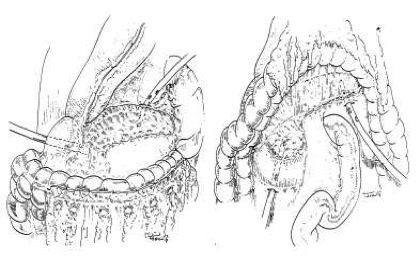Open necrosectomy
The principle of necrosectomy is minimization of injury to viable tissues and maximization of postoperative removal of exudative fluid and extravasated pancreatic exocrine secretions from the operative bed. It may be a very difficult procedure, associated with an increased risk of bleeding.
Open necrosectomy is traditionally performed via a midline or a subcostal laparotomy. Once the focus of necrosis is exposed, debridement is carried out bluntly. After all loose debris has been removed, the retroperitoneal cavity is irrigated with normal saline solution. After necrosectomy, four different techniques are used to provide exit channels for further slough and infected debris:
- Open packing (The abdomen is left open, continuous reoperations with open lavage of necrotic areas are performed)
- Planned staged relaparotomies with repeated lavage (The abdomen is closed, continuous relaparotomies with open lavage of necrotic areas are performed)
- Closed continuous lavage of the lesser sac and retroperitoneum (the abdomen is closed over drains for contained postoperative lavage of the lesser sac and involved retroperitoneum)
- Closed packing (the abdomen is closed, reabsorbable sponges are used for packing)
Prof. Perderzoli and Prof. Bassi from Verona were among the first to describe in 1990 the procedure of open necrosectomy with continuous lavage of the lesser sac and retroperitoneum (Figure 1).














